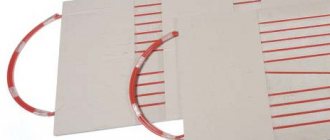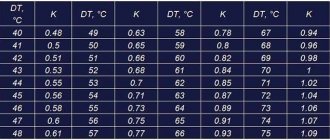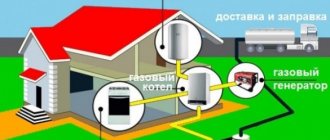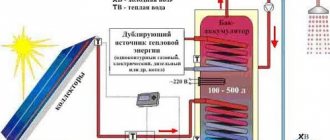On the modern heating equipment market you can find a wide range of equipment. Let's look at what a convector type heater is. Let's get acquainted with the features of radiators regarding connection, heat source and connection features. Read to the end and you will learn about the criteria that need to be taken into account before making a final decision to make your home comfortable and safe.
Floor convection heater Source bricomarche.pl
Warmth is the main joy in the cold season
Radiators - accumulate thermal energy received from the coolant, and then release it into the surrounding air.
You should approach this issue carefully: familiarize yourself with all possible market offers, choose the optimal price-quality ratio
It is necessary to take into account the layout and purpose of the room, the time people spend in the room with the heating device, as well as the location of the heater installation
To make the task easier, we will introduce you to the most popular and inexpensive heating options, namely convectors and radiators. The devices have stood the test of time and rightfully occupy a leading position among heaters. Let's consider the general characteristics of these heating devices, the principle of operation, as well as the pros and cons of each option. Let's try to determine what is better, more profitable and more reliable. Before we start choosing a heating device, let’s figure out how a radiator differs from a convector.
Heating devices - brief description
Radiator - serves to heat the room, operates on the principle of circulating water or antifreeze, in other words, it emits infrared radiation. As a rule, it is installed under the window, as it creates a “thermal plug” that does not let the cold into the room. A radiator is a structure consisting of several sections or panels, on which the amount of incoming heat and heat transfer depend. Previously, cast iron batteries were considered common, but progress has led to the widespread replacement of cast iron with aluminum.
A convector is a heating device that operates on the principle of convection: under the influence of a heating element, hot air is forced into the room, and cold air takes its place. That is, convection devices thoroughly mix the air layers of the room, thus creating the effect of a fan heater. This device consists of plates that pass air flows through them due to temperature differences, as well as channels, which are a key element, since the coolant passes through them. When using it, the heating of the air is 70-75%.
Disadvantages and advantages of heating devices, their differences
First of all, the difference between a convector and a radiator is the type of design and ribbing of the pipes, which significantly increases heat transfer. In addition, copper and aluminum are used in the manufacture of heating elements, which prevents metal corrosion. To operate the device, you need from 0.5 to 1 liter of water, which significantly saves energy costs. Light weight and simple design ensure ease of installation.
It is known that radiators are more efficient in terms of heat transfer. Compared to convector heaters, heating the radiator uses almost the entire area, which ensures constant heating of the room. Another advantage of radiator devices is their power and environmental friendliness, namely, air purity.
Convector disadvantages:
- lead to the formation of drafts in the room due to air movement from bottom to top;
- design features lead to the accumulation of dirt;
- Due to the peculiarities of the operating principle - convection, dust is constantly chasing around the room.
Radiator cons:
Operating principle of an oil cooler
Everything here is arranged quite simply. The oil cooler is a hermetically sealed reservoir filled with mineral oil. An electric heater is also located inside the structure. As a result of the operation of the heating element, the oil temperature rises, and then the walls of the tank heat up. The room is heated.
To prevent the oil from boiling, the system is equipped with a special sensor that controls the temperature. In addition, some models have horizontal control. This means that if the radiator accidentally tips over and the heating element is out of the oil environment, the automation will instantly turn off the device.
Oil radiators are very easy to use. No knowledge is required here. You just need to plug the plug into the outlet, press the power button and move the device closer. Some manufacturers equip their models with a timer that allows the device to automatically turn on at a certain time. This is very convenient if you want, for example, to return from work to an already well-warmed room. At the same time, the radiator remains turned off throughout the day and does not waste electricity.
What heats better, a convector or an oil radiator?
Significant differences in the operation of a convector from an oil radiator affect the thermal characteristics and thermal efficiency of the devices.
Thermal characteristics of oil radiators
The main advantage of an oil heater over an electric convector is its high heating temperature. If the radiator design has a fan heater, the room can be warmed up quickly enough.
The heater operates almost silently. The optimal solution would be to use a heating device in country houses. Maximum heating area 20-25 m².
Thermal efficiency of convectors
The convector is distinguished by a low heating temperature, no more than 60°C, creating a favorable microclimate. The device does not dry the air, but to warm up the room it will take longer than an oil radiator with a fan heater, but only if the heating element of the latter is heated to the required temperature. The performance of convectors is sufficient to provide heating of a room over 100 m².
The electric convector is distinguished by the best thermal characteristics and performance.
How to reduce costs
To keep heating costs at home lower, it is necessary to ensure minimal heat loss in the room.
Most of the heat escapes through doors, windows, attics and walls. Therefore, if the task is to reduce heat loss, first of all you should:
- Insulate windows by installing triple glazing or reducing window openings (or the number of windows). This will provide up to 10-20% heat retention.
- Insulate the doors. Or replace them with new ones with good thermal insulation.
- Insulate the attic. This will provide about 5-10% more heat.
- Insulate the walls by covering them with high-quality thermal insulation material. This gives another plus 20-30% or even 70% of heat.
Convection principle
Convector radiators operate from various energy sources. But the principle of their operation is the same. The air heated by the convector rises, and the cold masses fall down. The same process occurs in nature. At the same time, cyclones and winds are formed.
Heated air currents rush to the ceiling in the room, as they are lighter. Cold masses are determined near the floor. This movement occurs naturally. Some devices provide additional ventilation, which speeds up heat exchange processes.
But a conventional convector battery independently circulates air masses in the room. This is a simple but reliable way to heat your home quickly and with minimal energy costs.
Frame
Most often, steel is used for the manufacture of modern convectors. The design of the housing can be very diverse, so there are usually no problems with choosing a heater for a specific style of room. There are special fastenings (brackets) on the body of wall-mounted modifications: they make it possible to remove the device from time to time for maintenance.
In some cases, the protective steel box of the convector is equipped with adjustable blinds on the sides: by changing their angle, you can adjust the direction of air flow. This design solution allows for volumetric distribution of heat in the room, which makes its heating more uniform. To avoid underheating, when choosing a convector, it is recommended to leave some power reserve (especially if it is installed in a corner room).
Features of the convector heating system
The operating principle of convector heating
The very first convector heating batteries were traditional stoves. Thermal energy from their surface is transferred to the room. In this case, natural convection of air flows occurs - with a higher temperature they rise upward, creating heat circulation.
However, the efficiency of their work remains extremely low - the efficiency indicator did not exceed 25-30%. Therefore, convector heating boilers have been developed that transfer energy more efficiently. For this purpose, their design includes additional convector surfaces that improve circulation and, accordingly, the heating rate of the house.
How does convector heating at home differ from conventional heating?
- No pipelines. This reduces the primary costs of organizing heating;
- Possibility of installing local heating points - autonomous radiators. Most often this is done for dachas or houses with a small area, or apartments;
- Operational regulation of energy consumption to optimize temperature conditions.
The disadvantages of such a system include the complexity of the organization for buildings with a large area. Even if you install convector water heating consisting of autonomous radiators, it is problematic to create a single control unit. But there are exceptions - modern gas convector heating boilers. These are common models that can be installed in piping systems. The parameters for choosing such boilers are the same as when designing traditional heating systems.
The amount of energy generated in convector-type heating devices directly depends on the area of the heat exchanger
This is what you need to pay attention to first.
Video description
To find out which is more economical - an inverter heating system or heating using an electric boiler and radiators, see the following video:
Stereotype: Only for small houses
And in conclusion, regarding the prevailing opinion that convectors are only for houses with a small area with the number of heating points no more than 6. The objective disadvantages of a heating system with an electric boiler are characteristic of both small houses of 80-100 sq.m., and houses of a larger area. This means that the disadvantages of one system and the advantages of another are scaled to houses with a larger area of 200-300 sq.m.
Oil type heaters
These devices are very widely used to increase the air temperature in an apartment or house. Installing them is extremely simple; no special skills or knowledge are required. Plug the device into the outlet, placing it closer to the heated area - and you're done. Thanks to the simplest possible design, breakdowns of the device's electrical circuit are unlikely.
Several models of oil radiators - the one on the far left is equipped with a fan.
The design of the oil cooler is based on a metal reservoir with mineral oil poured inside it. The oil, in turn, contains a heating element. As a rule, a device of this type is equipped with a rheostat for temperature control, a compartment for the power cord and electrical protection against overheating. Sometimes the heater also has a sensor that detects deviation from the horizontal. This allows you to automatically turn off a device that has tipped over. Oil radiators are also splash-proof.
Oil radiators are equipped with a handle for easy movement around the apartment.
The heaters are equipped with swivel wheels.
The cord compartment is designed to store the power cable when not in use.
Advantages of the oil device:
- Low price;
- Quiet operation;
- Ease of movement over various distances, for example, from room to room.
To determine how much power the device will need to make the room warm, we will use the following rule. If the ceiling height does not exceed three meters, then to heat 10 square meters of space you need a radiator with a capacity of 1 kilowatt. Basically, similar devices are produced with a power range from 1 to 2.5 kilowatts.
The device usually has a thermostat that automatically sets the desired temperature, maintaining it at the same level. Models equipped with a timer are very convenient - it will turn on the heater at the appointed hour. For example, you can schedule heating for the morning or evening, when all household members arrive from work. Thus, the timer allows you to save a fair amount of electricity, which is very expensive today.
Heater with electronic control system.
Mechanical control system.
Radiators and gas convectors
If spot heating devices are sufficient to maintain the temperature in the room, it is recommended to install gas or electric convector-type heating. They consist of a heating element, a control unit and a combustion product removal system (gas models).
Electric heating convectors
Electric convector design
This is the easiest and fastest way to heat a house or apartment. The heating element is an electric heating element, the temperature of which is transferred to the body of the device. Using a system of slots, air freely penetrates inside the radiator, creating convection.
The most common models for convector heating systems have a tubular heating element with metal plates. This increases the heating area. But reviews talk about one drawback - extraneous sounds are heard during operation. The reason for this is the expansion of the metal of the plates.
To install convector heating batteries, the following conditions must be met:
- The cross-section of the electrical wiring must be designed for the maximum power of the device;
- It is recommended to install a separate RCD to prevent short circuits;
- According to safety rules, you cannot leave the convector on when no one is in the house.
You also need to take into account high energy costs. Therefore, if there is a gas main, convector heating radiators with a burner are chosen.
The cost of electric convectors ranges from 4,000 to 15,000 rubles
It is important to pay attention to the characteristics of the control unit, protection from water and the presence of automatic shutdown when tipping over
Gas heating convectors
Economical heating of a convector-type house can be done by installing gas models. They consist of a burner that is not located indoors. Air flow and combustion products removal are carried out through a coaxial chimney.
Unlike convectors for electric heating, gas models have large dimensions. This is due to the presence of a gas burner and a fairly large heat exchanger. To improve convection, some models install a fan to increase air exchange.
The average cost of gas convectors is 8000-12000 thousand rubles. Despite the large number of foreign brands, they prefer to purchase domestic analogues. They are better adapted to special operating conditions.
In what cases is the installation of convector heating at home justified? Reviews about it, the high cost of batteries and radiators indicate a balanced approach when choosing such a system. In most cases, it is relevant for small rooms and production workshops where it is necessary to provide zonal (selective) heating.
In the video you can familiarize yourself with the installation features of gas convectors:
A heating element
Electric convectors are equipped with various heating elements. The most inexpensive solution is steel products, found in the cheapest appliances. The high temperature of the heating coil (up to +160 degrees) allows the room to quickly warm up. However, spirals of this type have a low degree of safety: phenomena such as the accumulation of dust or accidentally ingress of water can cause the device to catch fire. The popularity of spiral convectors is explained, first of all, by their low cost. Some manufacturers additionally equip the device housing with special fans, which, in combination with a high-temperature coil, increases the heating intensity.
More expensive models are equipped with safe low-temperature coils that heat up only to +100 degrees. Elements of this type have the form of dissipative radiators made of aluminum with a built-in steel pipe. A special heating filament is located inside this tube. Thanks to the aluminum housing, heating efficiency is noticeably increased. In some models, instead of one, two tubes are used, which allows you to adjust the operation of the heating block.
The different degrees of expansion exhibited by aluminum and steel provoke a gradual decrease in the reliability of the connection between the heating tube and the housing. As a result, this can lead to a complete breakdown of the connection between them. As a result, there is a danger of local overheating of the tube and damage to the heating element. Manufacturers of convection equipment are constantly searching for a solution to this problem.
RX-Silence heating devices, developed and patented by NOIROT (France), are particularly unique. The innovative design of these convector boilers lies in the complete tightness of the silumin body, where magnesium powder is used to seal the nichrome heating filament. The expansion coefficient of the materials used has very similar values, which makes it possible to significantly reduce energy consumption and increase the service life of the convector to 15-17 years.
Difference between convection heater and radiator
The heating system only reminds itself with the arrival of cold weather. However, you need to prepare the sled in the summer. During the cold season, comfort indoors, be it a house, apartment or office, is vital. Heat supply is a serious issue, especially in the choice of radiators.
Designation
A heating device is a radiator in the middle of which a coolant (water, antifreeze) moves. The heating device returns heat to the room using infrared, in other words thermal, radiation. Heating of the room occurs from the window into the room. According to their design, heating devices are sectional, tubular and panel. The level of heating of the room depends on the number of attached sections or panels. Today, our usual cast iron sectional heating devices are being replaced with metal or bimetallic devices.
The material from which the radiator is made plays an important role in heat transfer
Heating device
The radiator design is a radiator that transfers heat using convection. Convection is a physical phenomenon in which air flows through the heater, increases in volume and enters the space of the room, while cooler air occupies the free space. Air circulation occurs in a real way, creating a temperature difference. In the design of a convector heater, the important elements are: a channel through which the coolant moves, and grates or plates through which air passes.
Radiator design to contents ^
When comparing heating devices and convector heaters, let’s turn our attention to the places of their use. So, for example, water heating radiators are perfect for office and industrial premises with an increased glazing area, and also with a very high level of moisture (greenhouses, semi-houses, semi-gardens, swimming pools)
Panel radiators made of steel are very often installed in cottages and cottages. To heat apartments in houses with centralized heating, today it is proposed to install bimetal radiators.
It is believed that in terms of heat output, heating devices give off more heat than convector heaters. This is due to the surface area, which is involved in the heat transfer process. Heating devices provide more constant heating of the air, and convector heaters can create a draft in the room. This phenomenon occurs due to the movement of air from bottom to top. And if the device does not cover the width of the window, then the air also moves from the window into the room. From a safety point of view, convector heaters are considered less hot than, say, a cast iron radiator. But due to the properties of the structure, dust collects in the design radiators.
Conclusions TheDifference.ru
- The heating device has a very high heat output;
- The heating device is more economical to operate; the radiator design requires more heat input;
- A heating device will cost much more than a radiator design;
- The heating device is more environmentally friendly, the design of the radiator collects and drives away dust;
- The heating device is more powerful and larger; the radiator design is more compact and can be built into walls and floors.
Comparative table of technical characteristics of oil and covector heaters
| Options | Oil heater | Convector heater |
| Economical | - Low economical. | +Approximately 25% more economical. |
| Heating time | + - Conventional models heat up for a long time, but those equipped with fans quickly. | —Heats the room for a long time. |
| Comfort to use | -Average. | +Both floor and wall models are more convenient. |
| Safety | —High surface temperature (but there are models with a protective casing); If the operating rules are violated, there is a risk of explosion. | +The surface of the convector is not subjected to strong heating; can be left unattended. |
| Life time | -Average | +Big |
| Environmental friendliness | —Due to convection, it raises dust particles | —Due to convection, it raises dust particles |
And based on the totality of all this, when deciding whether to choose a convector or an oil heater, you can clearly conclude: of course, a convector. Lightweight, compact, silent and safe, these heating devices are gradually replacing heavy, short-lived devices filled with hot oil from apartments and offices. So we can say that oil heaters have almost become a thing of the past in the matter of heating rooms. The only thing is that models of oil heaters equipped with fans are able to heat the room somewhat faster, but the process of heating its surface itself remains long. See below for detailed materials on choosing these heaters.
(no votes yet)
Main settings
Having figured out what convector heating is, you should arm yourself with general information about its technical characteristics. The power of electric convectors is in the range of 0.8 -3 kW, weight - from 3 to 9 kilograms.
Electric convectors currently available for sale are divided into three groups:
- High (450-670 mm).
- Medium (up to 330 mm).
- Narrow (for skirting boards), 140-200 mm high.
Due to their parameters, high-type heaters are able to provide a significant level of convection. Skirting models are equipped with less powerful heating elements. To maintain the proper level of efficiency, they are given a large length (up to 2.5 m).











